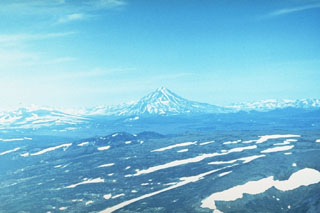Report on Mutnovsky (Russia) — August 1993
Bulletin of the Global Volcanism Network, vol. 18, no. 8 (August 1993)
Managing Editor: Edward Venzke.
Mutnovsky (Russia) Rock avalanches observed within summit crater
Please cite this report as:
Global Volcanism Program, 1993. Report on Mutnovsky (Russia) (Venzke, E., ed.). Bulletin of the Global Volcanism Network, 18:8. Smithsonian Institution. https://doi.org/10.5479/si.GVP.BGVN199308-300060
Mutnovsky
Russia
52.449°N, 158.196°E; summit elev. 2288 m
All times are local (unless otherwise noted)
During fieldwork on 17-18 September, two geologists from the IVGG noted large rock avalanches within the summit crater at intervals of several hours and intense melting of the glacier inside the crater. The observations indicate that activity inside the crater has increased compared to last year. The next day, a large rockslide (hundreds of thousands of tons of material) buried ~300 m of a trail in the crater under big blocks up to several meters high. Explosions from a vent in the central part of the crater ejected boiling mud several meters high. IVGG is advising hikers and other visitors to stay out of the crater until further notice.
Mutnovsky consists of four coalescing stratovolcanoes of predominantly basaltic composition with multiple summit craters. Holocene activity has been characterized by slight to moderate phreatic and phreatomagmatic eruptions. There have been 18 reported eruptions since historical activity began in the 17th century. The most recent activity was from December 1960 to January 1961, when weak explosive eruptions sent a gas-and-ash column 3.5-4 km high.
Geological Summary. Massive Mutnovsky, one of the most active volcanoes of southern Kamchatka, is formed of four coalescing stratovolcanoes of predominantly basaltic composition. Multiple summit craters cap the volcanic complex. Growth of Mutnovsky IV, the youngest cone, began during the early Holocene. An intracrater cone was constructed along the northern wall of the 1.3-km-wide summit crater. Abundant flank cinder cones were concentrated on the SW side. Holocene activity was characterized by mild-to-moderate phreatic and phreatomagmatic eruptions from the summit crater. Explosive eruptions have been common since the 17th century, with lava flows produced during the 1904 eruption.
Information Contacts: V. Kirianov, IVGG.

